

Quasi-Experimental Research – Research Methods in Psychology. Explain what quasi-experimental research is and distinguish it clearly from both experimental and correlational research.Describe three different types of quasi-experimental research designs (nonequivalent groups, pretest-posttest, and interrupted time series) and identify examples of each one.
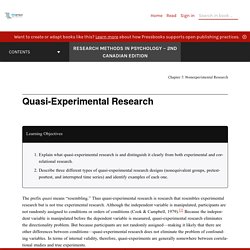
57732 Chapter 8. An overview of research designs relevant to nursing: Part 1: quantitative research designs. An overview of research designs relevant to nursing: Part 1: Quantitative research designs Valmi D.
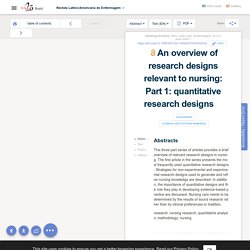
SousaI; Martha DriessnackII; Isabel Amélia Costa MendesIII. No Evidence for a Replicability Crisis in Psychological Science. A recent article by the Open Science Collaboration (a group of 270 coauthors) gained considerable academic and public attention due to its sensational conclusion that the replicability of psychological science is surprisingly low.
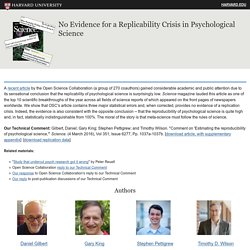
Science magazine lauded this article as one of the top 10 scientific breakthroughs of the year across all fields of science reports of which appeared on the front pages of newspapers worldwide. We show that OSC's article contains three major statistical errors and, when corrected, provides no evidence of a replication crisis. Indeed, the evidence is also consistent with the opposite conclusion -- that the reproducibility of psychological science is quite high and, in fact, statistically indistinguishable from 100%.
The moral of the story is that meta-science must follow the rules of science. Our Technical Comment: Gilbert, Daniel; Gary King; Stephen Pettigrew; and Timothy Wilson. Study that undercut psych research got it wrong. According to two Harvard professors and their collaborators, a widely reported study released last year that said more than half of all psychology studies cannot be replicated is itself wrong.

In an attempt to determine the “replicability” of psychological science, a consortium of 270 scientists known as the Open Science Collaboration (OSC) tried to reproduce the results of 100 published studies. More than half of them failed, creating sensational headlines worldwide about the “replication crisis” in psychology. But an in-depth examination of the data by Daniel Gilbert, the Edgar Pierce Professor of Psychology at Harvard, Gary King, the Albert J.
Weatherhead III University Professor at Harvard, Stephen Pettigrew, a Ph.D. student in the Department of Government at Harvard, and Timothy Wilson, the Sherrell J. Nothingnerdy - Natural Sciences. Back to HOME > IB ToK UNDERSTANDING SCIENCE 101 - good examples and definitions for your essays and presentationsSYMPHONY OF SCIENCE: POETRY OF REALITYTHE AQUATIC APE THEORY - example of unorthodox interpretation of evidence THE POWER OF THEORY FROM SCIENTIFIC AMMERICAN GUEST BLOG - ETHAN SIEGEL FROM THE TOK STUDY GUIDE: "The natural sciences reflect a concerted effort on the part of humans to search for understanding of the world.

Like any other human endeavour, the development of scientific knowledge forms a web with more practical, even everyday, interests and concerns. The natural sciences are recognized as a model for knowledge owing to many factors, prime among which is their capacity to explain and make precise predictions.
CHECKLIST FOR EVALUATING RESEARCH. Poses of power are less powerful than we thought. Hands pressed to the hips or perhaps leaning back with arms crossed behind the head are typical poses of power.

Referred to power poses or high status gestures in technical jargon, they are assumed to stimulate both psychological and physiological processes. Researchers around Amy Cuddy of Harvard Business School concluded in a study in 2010 that power poses held for a short time influenced the hormones and the willingness to take on financial risks for the subjects participating in the study. Scientists of the University of Zurich now refute these findings with a large study: power poses affect neither the masculine hormone testosterone, the stress hormone cortisol, nor the subjects' actual behavior. Power poses let subjects feel more powerful Bodily demonstrations of power, however, influence one's own perception of power, a result that the previous study also found.
It takes more than just one study. Wiersma,Wybo,The_validity_of_surveys_online_and_offline.pdf. Classics in the History of Psychology. Classics in the History of Psychology An internet resource developed byChristopher D.
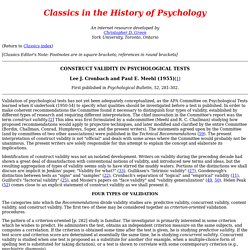
Green York University, Toronto, Ontario (Return to Classics index) [Classics Editor's Note: Footnotes are in square brackets; references in round brackets] Lee J. First published in Psychological Bulletin, 52, 281-302. Validation of psychological tests has not yet been adequately conceptualized, as the APA Committee on Psychological Tests learned when it undertook (1950-54) to specify what qualities should be investigated before a test is published. People interpret my data in different ways. Psychology Article Critique. Research and Development. What is test validity and test validation?

Tests themselves are not valid or invalid. Instead, we validate the use of a test score. Tests are pervasive in our world. 3. Populations and samples. Populations In statistics the term "population" has a slightly different meaning from the one given to it in ordinary speech.
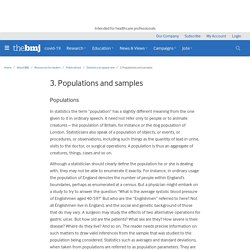
It need not refer only to people or to animate creatures - the population of Britain, for instance or the dog population of London. Statisticians also speak of a population of objects, or events, or procedures, or observations, including such things as the quantity of lead in urine, visits to the doctor, or surgical operations. A population is thus an aggregate of creatures, things, cases and so on. Although a statistician should clearly define the population he or she is dealing with, they may not be able to enumerate it exactly.
Samples A population commonly contains too many individuals to study conveniently, so an investigation is often restricted to one or more samples drawn from it. To draw a satisfactory sample sometimes presents greater problems than to analyse statistically the observations made on it. Unbiasedness and precision Randomisation . Table 3.1. PRISMA Meta-analysis methods. The PRISMA Statement The aim of the PRISMA Statement is to help authors report a wide array of systematic reviews to assess the benefits and harms of a health care intervention.
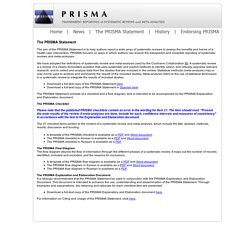
PRISMA focuses on ways in which authors can ensure the transparent and complete reporting of systematic reviews and meta-analyses. External Validity. « PreviousHomeNext » External validity is related to generalizing. That's the major thing you need to keep in mind. Recall that validity refers to the approximate truth of propositions, inferences, or conclusions. So, external validity refers to the approximate truth of conclusions the involve generalizations. Put in more pedestrian terms, external validity is the degree to which the conclusions in your study would hold for other persons in other places and at other times.
In science there are two major approaches to how we provide evidence for a generalization. I'll call the second approach to generalizing the Proximal Similarity Model. Threats to External Validity A threat to external validity is an explanation of how you might be wrong in making a generalization. Improving External Validity How can we improve external validity? Copyright �2006, William M.K. Internal Validity. Educational Research. Structured Qualitative Research: Organizing “Mountains of Words” for Data Analysis, both Qualitative and Quantitative. Mixed Methods Research Index. False Genetics of Intelligence. Choosing the Correct Statistical Test in SAS, Stata and SPSS. The following table shows general guidelines for choosing a statistical analysis. We emphasize that these are general guidelines and should not be construed as hard and fast rules.
Usually your data could be analyzed in multiple ways, each of which could yield legitimate answers. Page1.jpg (JPEG Image, 1600 × 1232 pixels) - Scaled (46. Page2.jpg (JPEG Image, 1600 × 1234 pixels) - Scaled (46. Page3.jpg (JPEG Image, 1600 × 1234 pixels) - Scaled (46. Microsoft PowerPoint - 520in_ex_validity - 520in_ex_validity.pdf. Discredited medical procedures heart. Six problems for causal inference from fMRI. Beware the Nocebo Effect.